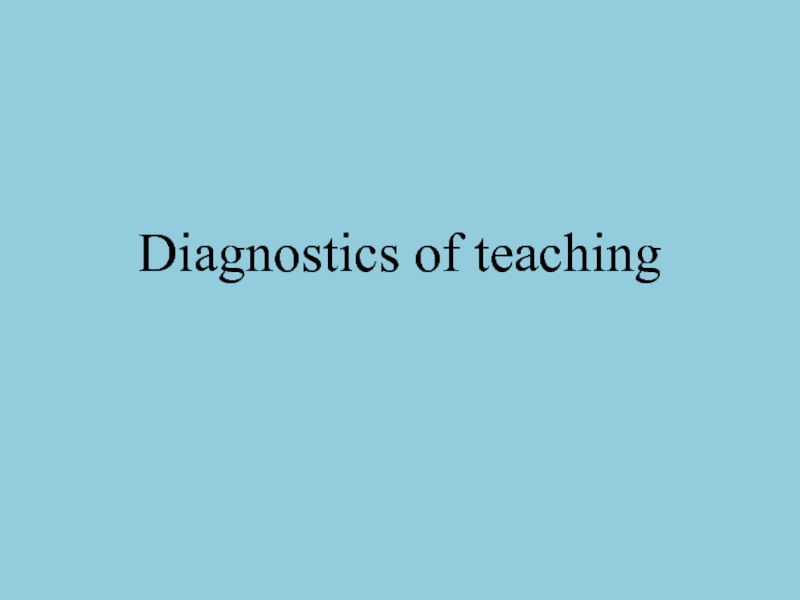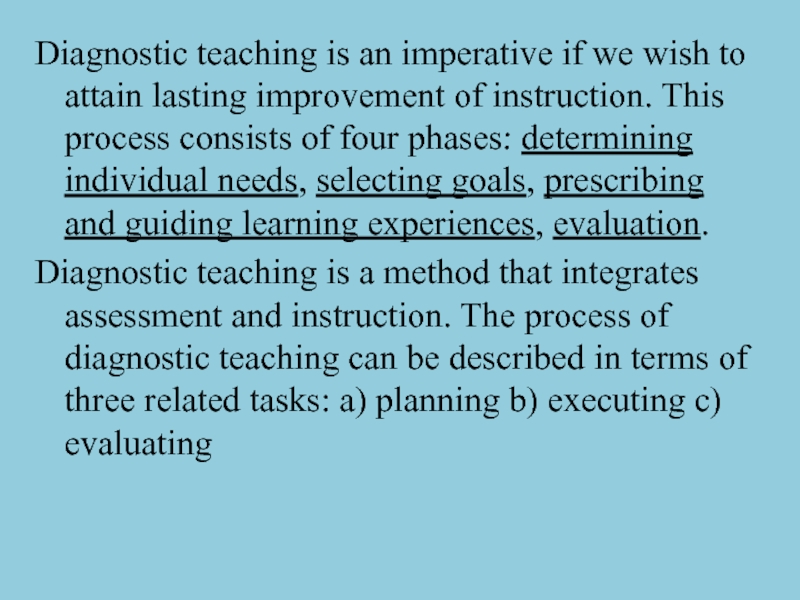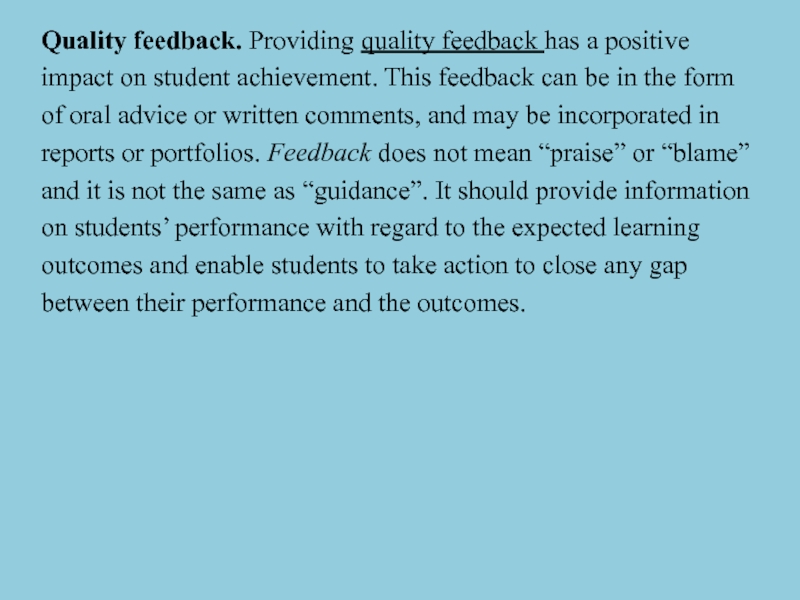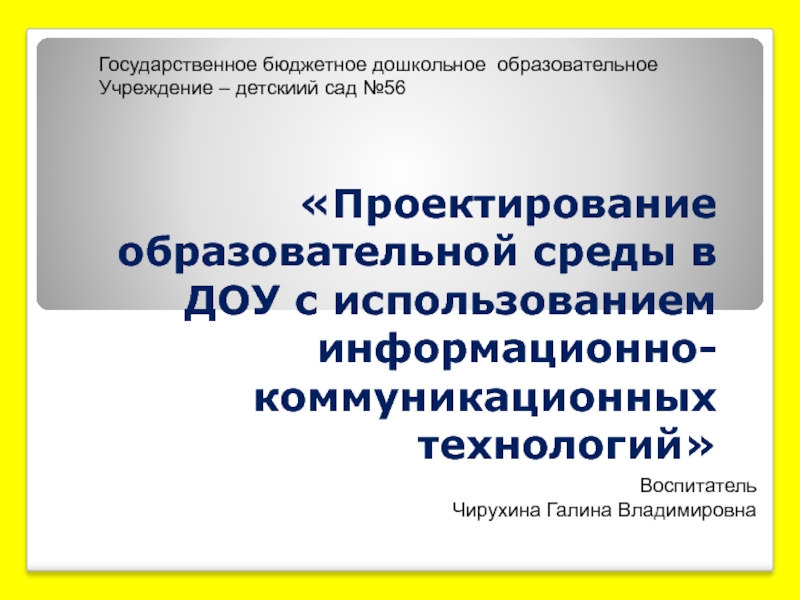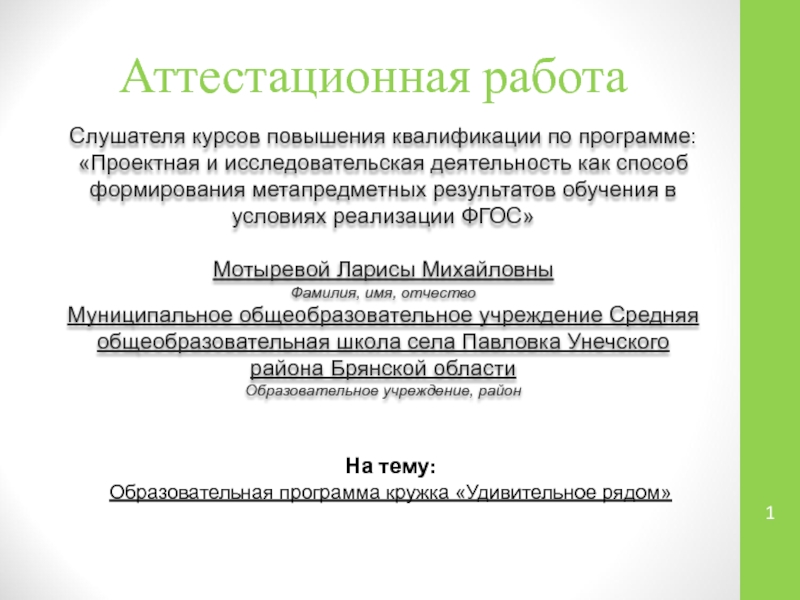- Главная
- Разное
- Дизайн
- Бизнес и предпринимательство
- Аналитика
- Образование
- Развлечения
- Красота и здоровье
- Финансы
- Государство
- Путешествия
- Спорт
- Недвижимость
- Армия
- Графика
- Культурология
- Еда и кулинария
- Лингвистика
- Английский язык
- Астрономия
- Алгебра
- Биология
- География
- Детские презентации
- Информатика
- История
- Литература
- Маркетинг
- Математика
- Медицина
- Менеджмент
- Музыка
- МХК
- Немецкий язык
- ОБЖ
- Обществознание
- Окружающий мир
- Педагогика
- Русский язык
- Технология
- Физика
- Философия
- Химия
- Шаблоны, картинки для презентаций
- Экология
- Экономика
- Юриспруденция
Diagnostics of teaching презентация
Содержание
- 1. Diagnostics of teaching
- 2. DIAGNOSTICS OF TEACHING When teachers become skilled
- 3. Diagnostic teaching is an imperative if we
- 6. Pedagogical measurements Assessment is an integral part
- 7. The roles of assessment for different stakeholders
- 8. Why assessment? – helping students meet certain
- 9. Formative assessment provides feedback and information during
- 10. Summative assessment takes place after the learning
- 11. Diagnostic assessment can help you identify your
- 12. This type of testing/evalutation spans two columns: Standardized tests
- 13. Dynamic assessment measures what the student achieves
- 14. Synoptic assessment combines two
- 15. Criterion referenced assessment Each student’s achievement is
- 16. Ipsative assessment This is assessment against the
- 19. Quality feedback. Providing quality feedback has a
- 20. Seminar Tasks Diagnostic Teaching Assessment is the
- 21. Project works 1. Diagnostic Teaching: assessment and
- 22. References 1. Gronlund, N. E. (2008). Assessment of
Слайд 2DIAGNOSTICS OF TEACHING
When teachers become skilled at managing the classroom and
Diagnostic teaching reflects the dual purposes for which the procedure is used:
Diagnostic – allows the collection of additional information in order clarify and test hypothesis about what the reader needs.
Instruction – provides opportunities to try out methods for working with a student.
Слайд 3Diagnostic teaching is an imperative if we wish to attain lasting
Diagnostic teaching is a method that integrates assessment and instruction. The process of diagnostic teaching can be described in terms of three related tasks: a) planning b) executing c) evaluating
Слайд 4
Diagnostic Teaching
Diagnostic teaching is a hypothesis driven method
that links assessment and
determine student abilities, needs, and
in order to prescribe requisite learning
opportunities.
objectives
Plan
Execute
Evaluate
Prescribe
Слайд 5
Diagnostic Teaching
Specifying objectives.
Determining the
abilities, needs, and
objectives of individual
learners.
Prescribing and guiding learning
Current
State
Feedback
How to
improve
Learning
Outcome
Diagnostic
Assessment
Action
Evaluation
Resources
Assisting in evaluation of progress.
Слайд 6Pedagogical measurements
Assessment is an integral part of the curriculum, pedagogy and
Слайд 7The roles of assessment for different stakeholders can be summarized as
For students to
understand the learning objectives from a different perspective and how well they are progressing towards their objectives;
understand what they need to improve on the next stage of learning; and understand their strengths and weaknesses in learning and how to take steps to improve and to self-regulate their work.
For teachers and schools to
understand the strengths and weaknesses of students in learning;
recognize the effectiveness of learning and teaching practices and make adjustment to their teaching;
monitor the standards and quality of the education they are providing and guide students towards appropriate future learning.
Слайд 8Why assessment?
– helping students meet certain standards
– using the assessment data
- Assessment is the process of gathering data
3 types of assessments:
diagnostic, formative, and summative
Слайд 9Formative assessment provides feedback and information during
the instructional process, while learning
learning is occurring. Formative assessment is the act of
collecting evidence of student learning (e.g. classroom
observation, class activities, homework, quizzes) and providing
feedback to promote better learning.
Types of Formative Assessment
Observations during in-class activities; of students non-verbal feedback during lecture
Homework exercises as review for exams and class discussions)
Reflections journals that are reviewed periodically during the semester
Question and answer sessions, both formal—planned and informal—spontaneous
Conferences between the instructor and student at various points in the semester
In-class activities where students informally present their results
Student feedback collected by periodically answering specific question about the instruction and their self-evaluation of performance and progress
Слайд 10Summative assessment takes place after the learning has been
completed and provides
teaching and learning process. Summative assessment is usually
carried out at the end of a teaching unit/ school term/ school year in
order to sum up what students have learnt (e.g. end-of-unit test/ task).
Types of Summative Assessment
Examinations (major, high-stakes exams)
Final examination (a truly summative assessment)
Term papers (drafts submitted throughout the semester would be a formative assessment)
Projects (project phases submitted at various completion points could be formatively assessed)
Portfolios (could also be assessed during it’s development as a formative assessment)
Performances
Student evaluation of the course (teaching effectiveness)
Instructor self-evaluation
Слайд 11Diagnostic assessment can help you identify your students’
current knowledge of a
and to clarify misconceptions before teaching takes place.
Knowing students’ strengths and weaknesses can help you better
plan what to teach and how to teach it.
Types of Diagnostic Assessments
Pre-tests (on content and abilities)
Self-assessments (identifying skills and competencies)
Discussion board responses (on content-specific prompts)
Interviews (brief, private, 10-minute interview of each student)
Like formative assessment, diagnostic assessment is intended to
improve the learner’s experience and their level of achievement
Слайд 13Dynamic assessment measures what the student achieves when given some teaching
Dynamic assessment generally uses a repetitive process of pretest-teach-retest. A pretest is given to discover what information the student already knows. A teaching time on the unknown material follows the pretest, and then another similar test is given.
Слайд 14 Synoptic assessment combines two or more modules of
Synoptic assessment – is a form of assessment which requires a learner to demonstrate that they can identify an use skills, techniques, concepts, theories and knowledge across a whole vocational area
Слайд 15Criterion referenced assessment
Each student’s achievement is judged against specific criteria. In
principle no account is taken of how other students have
performed. In practice, normative thinking can affect
judgements of whether or not a specific criterion has been met.
Reliability and validity should be assured through processes such
as moderation, trial marking, and the collation of exemplars.
EvaluationEvaluation that attemptsEvaluation that attempts to uncover the strengthsEvaluation that attempts to uncover the strengths and weakness of
a student or trainee in terms of what he or she knows or doesn't
know, understands or doesn't understand, or can do or cannot do,
as measured against a benchmarkas measured against a benchmark or standard. To know specific
skills which have achived.
Also calledAlso called contentAlso called content referenced assessmentAlso called content referenced assessment or criterion referenced
test.
Слайд 16Ipsative assessment
This is assessment against the student’s own previous standards. It
An individual’s performance is judged in comparison to her/his other performances, either in the same domain at different times or in different domains. Is a student’s own self-referenced assessment
An ipsative assessment compares current performance with a previous performance.
An ipsative assessment compares current performance with a previous performance
Слайд 19Quality feedback. Providing quality feedback has a positive
impact on student
of oral advice or written comments, and may be incorporated in
reports or portfolios. Feedback does not mean “praise” or “blame”
and it is not the same as “guidance”. It should provide information
on students’ performance with regard to the expected learning
outcomes and enable students to take action to close any gap
between their performance and the outcomes.
Слайд 20Seminar Tasks
Diagnostic Teaching
Assessment is the process of gathering data
Differences between testing,
Pedagogical measurements in Kazakhstan
Some issues on assessment techniques
Слайд 21Project works
1. Diagnostic Teaching: assessment and instruction
2. General assessment tools
3. Specific
4. Classroom Questioning
5. Methods of examination of cognitive development, diagnostic training, qualitative and quantitative evaluation
6. Advances in teacher assessments and their use.
7. Improving longitudinal data on student achievement
8. The effect of school resources on student achievement
Слайд 22References
1. Gronlund, N. E. (2008). Assessment of Student Achievement. Boston: Allyn &
2. Assessment Reform Group. (1999). Assessment for Learning: Beyond the Black Box. Cambridge: University of Cambridge School of Education.
3. Clarke, S. (2001). Recommendations for the development of formative assessment in Hong Kong. Hong Kong: Education Department.
4. Ebel, R. L. (1979). Essentials of Educational Measurement. New Jersey: Prentice Hall.
